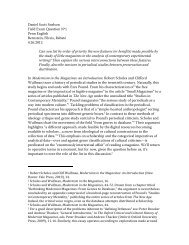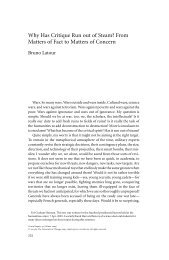The Exploit: A Theory of Networks - asounder
The Exploit: A Theory of Networks - asounder
The Exploit: A Theory of Networks - asounder
Create successful ePaper yourself
Turn your PDF publications into a flip-book with our unique Google optimized e-Paper software.
86 Nodes<br />
is, in a way, an “animality” specific to the biological virus, for it acts<br />
as a connector between living forms, traversing species, genus, phylum,<br />
and kingdom. In the late twentieth century and the early twenty -<br />
first, public health organizations such as the WHO and the CDC began<br />
to see a new class <strong>of</strong> diseases emerging, ones that were caused by<br />
rapidly mutating microbes and were able to spread across the globe in<br />
a matter <strong>of</strong> days.<br />
<strong>The</strong>se “emerging infectious diseases” are composed <strong>of</strong> assemblages <strong>of</strong> living<br />
forms: microbe-flea-monkey-human, microbe-chicken-human, microbe-cowhuman,<br />
or human - microbe - human. In a sense, this is true <strong>of</strong> all epidemics: in<br />
the mid - fourteenth century, the Black Death was an assemblage <strong>of</strong> bacillus -<br />
flea - rat - human, a network <strong>of</strong> contagion spread in part by merchant ships<br />
along trade routes.<br />
Biological viruses are connectors that transgress the classification<br />
systems and nomenclatures that we define as the natural world or<br />
the life sciences. <strong>The</strong> effects <strong>of</strong> this network are, <strong>of</strong> course, far from<br />
desirable. But it would be misleading to attribute maliciousness and<br />
intent to a strand <strong>of</strong> RNA and a protein coating, even though we humans<br />
endlessly anthropomorphize the nonhumans we interact with.<br />
What, then, is the viral perspective? Perhaps contemporary micro -<br />
biology can give us a clue, for the study <strong>of</strong> viruses in the era <strong>of</strong> the<br />
double helix has become almost indistinguishable from an information<br />
science. This viral perspective has nothing to do with nature, or<br />
animals, or humans; it is solely concerned with operations on a code<br />
(in this case, a single - strand RNA sequence) that has two effects—<br />
the copying <strong>of</strong> that code within a host organism, and mutation <strong>of</strong><br />
that code to gain entry to a host cell.<br />
Replication and cryptography are thus the two activities that define the<br />
virus. What counts is not that the host is a “bacterium,” an “animal,” or a<br />
“human.” What counts is the code—the number <strong>of</strong> the animal, or better,<br />
the numerology <strong>of</strong> the animal.<br />
We stress that the viral perspective works through replication and<br />
cryptography, a conjunction <strong>of</strong> two procedures. Sticking to our ex -









